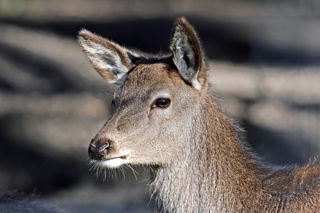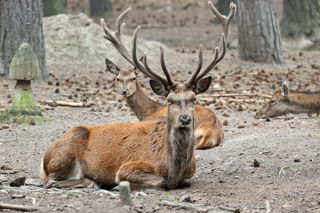
Red Deer
Cervus elaphus
Male red deer (stags) can be as tall as 1.4m and weigh between 90-190kg and females (hinds) weigh between 63-120kg and stand up to 1.20m tall. Their fur is reddy-brown in colour with no patterns or spotting when adults, only a pale rump patch.
The stag’s antlers are impressive; they are branched (with around three main branches) and start to grow in spring. By August/September time, they are fully grown with no velvet on them.
Behaviour
Like most deer, Red deer are active throughout the 24-hour period, but most activity occurs at dawn and dusk (especially in more open areas). Red deer that live in woodlands tend to be more solitary, compared to those found in more open environments that form much larger single sex groups (outside of the breeding season).
The rut (breeding season) occurs from September to November. This is when mixing of the sexes happen; stags compete amongst the herds of hinds for mating rights, performing elaborate displays of dominance such as parallel walks, roaring and as a last resort, physical fights.
UK Status
Although the largest numbers of red deer in the UK occur in Scotland, there are some small populations in north west England, East Anglia, Exmoor and Ireland. During the end of the 18th century, they had actually become extinct in most of England, Wales and some parts of Scotland.
Their decline started not long after the development of agriculture, as this resulted in habitat loss. The Normans and then Victorians had a fondness for ornamental species and reintroduced them to some parts of the country to be kept in deer parks. Escapees from these areas, natural spread and woodland recovery in the highlands resulted in their current UK distribution.
In some areas where population densities are high, culling and deer stalking for sport is carried out in an attempt to control numbers. They have been shown to cause quite a lot of damage to woodland and agricultural crops etc.
Threats
Hybridisation with introduced species (sika deer), particularly the populations in the Lake District. Deer culling is also a major limiting factor for deer numbers in the UK, although current rates in the Highlands are shown not to stop population increases.

Distribution
Patchy distribution that extends from Europe, into north African and the Middle East. Some regional populations have become extinct and then subsequently reintroduced (such as those in Ireland, Greece and Portugal).
Habitat
Are known to inhabit woodlands (mixed, broad leafed or coniferous), as well as open areas such as moors, grasslands, meadows and open mountainous regions. In the UK, their main habitat is open moorlands in the highlands of Scotland and islands.
Diet
Grazers that feed on a variety of different grasses and rushes (majority of their diet). During the winter, when food can be limited, tree shoots, shrubs (such as heather) and woody browse is also consumed.
Wildwood inside info
We are home to a mixed herd of red deer. You can find them in our top forest area, within a pine forest, opposite the bison paddocks and the elk enclosure.
Family facts
They are the 4th largest deer species.
In medieval hunting, red deer were the most impressive trophy item, and a mature stag was called a “hart”.
-
![2023.02.01Reddeer]()
Wildwood animal adoptions last for one year and are the perfect gift for any animal lover. Each adoption helps support our work to save British wildlife. We have different levels of adoption available to suit all occasions and budgets.
ADOPT ME!
-
![Red Deer Family]()
Find out how you can support our conservation work and join our fight.
Support us



